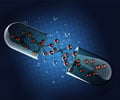Scientists have developed a sperm-driven micromotor system that uses the sperm as a carrier for targeted drug delivery to cervical cancer cells.
Highlights:
- In this research, scientists Xu et al., from Germany
explore a new hybrid sperm micromotor which has the potential to deliver
targeted drugs in gynecological cancers
- The researchers loaded the motile sperm with an
anticancer drug (doxorubicin hydrochloride) and guided it to a tumor cell
where the drug was delivered via sperm-cancer cell membrane fusion
- The researchers found that sperms have the natural
ability to load and deliver drugs and do not express disease-causing proteins, qualities that make
them excellent vehicles for delivering anti-cancer drugs especially in the
female reproductive system.
The challenge in treating cancers is the lack of an
effective drug-delivery system providing local dosing in controlled amounts.
Targeted drug delivery is important to
minimize the side effects of cancer treatments. Research has experimented
with various carrier vehicles like stem cells and bacteria to act as drug
delivery systems. The challenge was for the drug to reach the actual organ
without getting diluted by other body fluids. When bacteria were used as
carriers, the body’s immune system tracked the bacteria down and destroyed
them. Scientists Xu et al., from Germany were looking for a viable,
self-propelled cell as a safe alternative to carrying drugs into cancer cells.
In this research, the authors explore
a novel bio-carrier which has the potential to deliver targeted drugs
in gynecological cancers including
cervical, ovarian, vaginal, uterine, vulvar and fallopian tube cancers.
Sperms are naturally suited for swimming in the female reproductive tract and
presented a viable option. The researchers reported a
new hybrid sperm micromotor which consists of a motile sperm for
propulsion and used as a drug carrier, and a 3D printed four-armed microtube
known as a tetrapod used for guiding and delivering the drug. The researchers
loaded motile bovine sperm with an
anticancer drug (doxorubicin hydrochloride – DOX-HCl) and guided
it to tumor spheroids. They first used it on HeLa cells and then on HeLa
spheroids.
When the biohybrid micromotor
hit the tumor wall, the sperm was freed enabling it to swim into the tumor and
deliver the drug via sperm-cancer cell membrane fusion. The researchers
found that DOX-HCl was evenly distributed in the HeLa cell clusters indicating
high tumor-cell killing efficiency within the first 48 hours.
The researchers found that the sperm cell has the naturally
ability to load and deliver drugs. The sperms had high drug encapsulation
ability when compared to other biocarriers like liposomes or other synthetic
carriers. The sperm cells were also able to improve drug transfer to target
cells and increase drug bioavailability because of their somatic cell fusion
ability. Sperm hybrid micromotors have the advantage of controlled guiding and
release mechanism. These micromotors can deliver drugs to the precise tumor
tissue and also avoid accumulation of the drug in other healthy tissues. In
their previous research, the authors had showed how micromotors were
successfully used to transport and guide single-sperm cells for assisted in
vivo fertilization. Their novel micromotor system has all the
advantages including self-propulsion,
targeted in situ release of drug-loaded sperm, ability to penetrate to the
right tissue and high drug loading capacity.
Unlike other microorganisms, sperms do not express
disease-causing proteins or form other undesirable colonies. The researchers
found that sperms were able to navigate complex environments. Sperms can also
remain functional in the body as opposed to other foreign agents because of
their ability to inhibit immune response. The qualities of the sperm make it an
excellent vehicle for delivering anti-cancer drugs or any other drug especially
in diseases of the female reproductive system. The researchers believe
sperm-hybrid systems have immense potential
for application in situ cancer diagnosis and treatments.
Reference:
- Haifeng Xu, et al., “Sperm-Hybrid Micromotor for Targeted Drug Delivery,” ACS Nano, (2017); DOI: 10.1021/acsnano.7b06398
Source-Medindia















